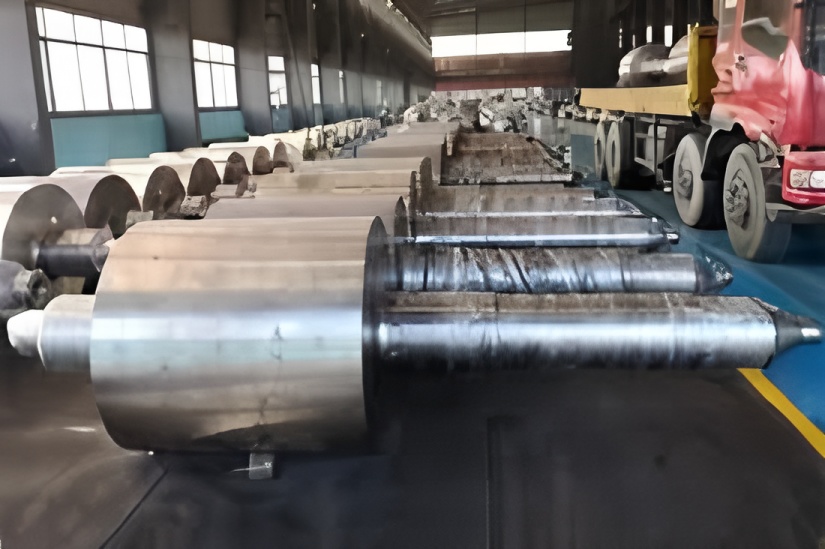Description: Rolling mill rolls are critical equipment that directly contacts and deforms billets under pressure during the rolling process to meet various steel standards. As a result, these rolls must exhibit high fatigue strength and wear resistance.
Keywords: Rolling mill roll life, steel rolling process
In recent years, through optimization of the steel rolling process and improvements in roll performance via technical measures, significant enhancements have been achieved in roll hardness, thermal crack resistance, and impact resistance. This has effectively reduced roll consumption and extended service life. This article analyzes issues such as irregular spalling, roll ring cracking, and groove cracking, and proposes improved roll cooling strategies tailored to current production line conditions.
Rolls are essential components in the rolling process. They contact billets directly and apply pressure to deform them, meeting various steel standards. Thus, rolls must possess high fatigue strength and wear resistance. With growing market demand for rolled steel products, roll consumption has increased considerably, raising production costs. Consequently, improving rolling productivity, reducing roll replacement frequency, and extending roll service life have become key concerns in the metallurgical industry.
Rolls operate under high temperature, high pressure, alternating thermal cycles, and exposure to oxide scale. Subjected to mechanical stress, friction, thermal stress, and impact loads, rolls are prone to wear, cracking, and spalling, which significantly shorten their lifespan. As a critical part of mill operations with high procurement costs, roll consumption is a major economic factor in production expenses.
Importance of Extending Roll Service Life
Rolls are vital for the continuous plastic deformation of metal in rolling mills and represent a high-consumption item that constitutes a substantial portion of production costs. An effective roll management system enables clear tracking of each roll’s condition and usage, ensuring proper matching and utilization, maximizing roll service life, and determining optimal grinding amounts. This not only reduces roll fatigue and minimizes abnormal roll replacements but also enhances rolling line productivity and overall efficiency. The effectiveness of roll management is crucial for reducing production costs and extending roll service life.
Dedicated personnel should manage rolls, maintaining records for acceptance, matching, usage, crack detection, and abnormal removals. Such systematic management controls each roll’s lifecycle, which is essential for reducing consumption and increasing service life.
Common Roll Issues in Production
Irregular Spalling at Groove Center: Excessive copper content in the groove center can cause irregular spalling. During heating, copper flow on the inner wall forms low-melting-point phases, reducing thermoplasticity and initiating cracks that expand over time. In hot-rolled narrow strip steel, inconsistent groove wear due to insufficient daily supervision and incomplete crack removal during repairs can lead to macro-cracks and groove failure.
Roll Ring Cracking: Roll rings are affected by assembly, thermal, and rolling stresses. High tangential tensile stress at the inner diameter and localized stress concentrations can cause cracking.
Pitting in Rolling Groove: Surface pitting, characterized by roughness and unevenness, is a common defect. While acceptable within depth limits, pitting results from worn passes, iron oxide damage, roll erosion, or severe billet surface oxidation.
Roll Fracture: Impact, tail flicking, or clamping can cause cracks and soft spots on or below the roll surface, severely affecting production and roll lifespan. Severe cracks lead to premature spalling or breakage.
Cause Analysis:
These issues arise from improper operation, inadequate cooling, key rolling process oversights, or roll quality problems. Poor cooling causes surface temperature differentials, accelerating thermal stress and spalling. Overheating reduces roll strength and wear resistance, leading to bursting, spalling, or fracture. unsuitable roll material selection or human errors (e.g., rolling accidents, pile-ups) also contribute to these failures.
Brittle inclusions (e.g., SiO₂, Al₂O₃, silicates) in steel materials adversely affect roll life, with severity depending on their quantity, size, and type. Larger, sharper inclusions are particularly harmful.
Process Improvement Measures
Roll Cooling System Enhancement: Improving cooling water utilization and efficiency is vital. Rolling generates significant heat, necessitating cooling to maintain replacement cycles, service life, and post-processing temperature. Primary and secondary cooling systems lubricate, cool, and prevent oxidation. High-speed rolling (main drive ≥1300 rpm, auxiliary ≥700 rpm) requires strict control of water flow and pressure. A cooling rate ≥3500 L/h and pump pressure ≤0.8 MPa are essential to maintain roll temperature stability.
Cooling Water Parameters and Supply System Optimization: Cooling water temperature should be 40–60°C. Extreme temperatures accelerate fatigue or affect recrystallization and product quality. Upgrading to medium-turbidity water supply with variable-frequency motors maintains 0.8 MPa pressure with automatic adjustment.
Groove Configuration Optimization: For hot-rolled narrow strip steel, forced widening is applied at K3 and K4 stands with a straight groove bottom and 17.7° slope to prevent wrinkles. Corresponding adjustments to K6 groove size prevent tailing.
Roll Material Optimization: For Q215 hot-rolled narrow strip steel, increasing the roll gap to 22.0 mm and adjusting the middle roll ring width to 10.8 mm reduces cracking under fatigue conditions.
Automatic Gauge Control (AGC) Modification: AGC uses model algorithms to control strip thickness, adjusting juice pressure, speed, and roll gap to ensure thickness deviation. Hydraulic systems offer high precision and speed.
Prevention of Improper Operation: Avoid direct guide-roll contact; enforce cooling water protocols; enhance inspections; control material shape per process requirements; clean billet heads thoroughly; prohibit rolling over black steel.
Adequate Grinding: Ensure each groove’s output remains stable without excess cracks. Grinding must remove the fatigue layer completely. For example, the grinding amount for Q215 hot-rolled narrow strip steel finish rolls must reach 600 mm.
Conclusion
Implementing these measures significantly extends roll service life, reduces replacement frequency, and lowers labor intensity. Addressing irregular spalling, cracking, and pitting minimizes cooling-related defects, improves product quality, and enhances overall operational efficiency.


